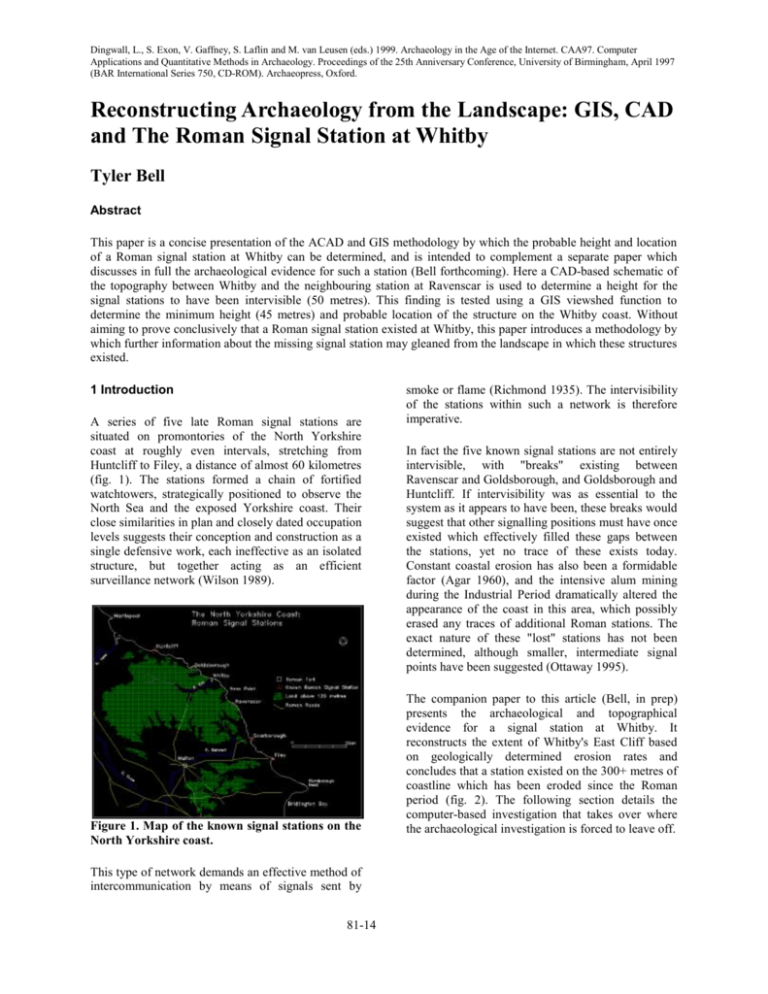Tyler Bell - CAA Proceedings Online
advertisement

Dingwall, L., S. Exon, V. Gaffney, S. Laflin and M. van Leusen (eds.) 1999. Archaeology in the Age of the Internet. CAA97. Computer Applications and Quantitative Methods in Archaeology. Proceedings of the 25th Anniversary Conference, University of Birmingham, April 1997 (BAR International Series 750, CD-ROM). Archaeopress, Oxford. Reconstructing Archaeology from the Landscape: GIS, CAD and The Roman Signal Station at Whitby Tyler Bell Abstract This paper is a concise presentation of the ACAD and GIS methodology by which the probable height and location of a Roman signal station at Whitby can be determined, and is intended to complement a separate paper which discusses in full the archaeological evidence for such a station (Bell forthcoming). Here a CAD-based schematic of the topography between Whitby and the neighbouring station at Ravenscar is used to determine a height for the signal stations to have been intervisible (50 metres). This finding is tested using a GIS viewshed function to determine the minimum height (45 metres) and probable location of the structure on the Whitby coast. Without aiming to prove conclusively that a Roman signal station existed at Whitby, this paper introduces a methodology by which further information about the missing signal station may gleaned from the landscape in which these structures existed. 1 Introduction A series of five late Roman signal stations are situated on promontories of the North Yorkshire coast at roughly even intervals, stretching from Huntcliff to Filey, a distance of almost 60 kilometres (fig. 1). The stations formed a chain of fortified watchtowers, strategically positioned to observe the North Sea and the exposed Yorkshire coast. Their close similarities in plan and closely dated occupation levels suggests their conception and construction as a single defensive work, each ineffective as an isolated structure, but together acting as an efficient surveillance network (Wilson 1989). Figure 1. Map of the known signal stations on the North Yorkshire coast. This type of network demands an effective method of intercommunication by means of signals sent by 81-14 smoke or flame (Richmond 1935). The intervisibility of the stations within such a network is therefore imperative. In fact the five known signal stations are not entirely intervisible, with "breaks" existing between Ravenscar and Goldsborough, and Goldsborough and Huntcliff. If intervisibility was as essential to the system as it appears to have been, these breaks would suggest that other signalling positions must have once existed which effectively filled these gaps between the stations, yet no trace of these exists today. Constant coastal erosion has also been a formidable factor (Agar 1960), and the intensive alum mining during the Industrial Period dramatically altered the appearance of the coast in this area, which possibly erased any traces of additional Roman stations. The exact nature of these "lost" stations has not been determined, although smaller, intermediate signal points have been suggested (Ottaway 1995). The companion paper to this article (Bell, in prep) presents the archaeological and topographical evidence for a signal station at Whitby. It reconstructs the extent of Whitby's East Cliff based on geologically determined erosion rates and concludes that a station existed on the 300+ metres of coastline which has been eroded since the Roman period (fig. 2). The following section details the computer-based investigation that takes over where the archaeological investigation is forced to leave off. investigation regarding the probable height of the Whitby station. Figure 2. A possible reconstruction of Whitby's Roman and Anglo-Saxon period coastlines based on the erosion rates established by Agar 1960. 2 Background Because we are left with no structural evidence of a signal station at Whitby, its precise location on the now-eroded cliff must remain a matter of some speculation. However, a logical inquiry can narrow the possibilities: the current abbey now lies within the 55 metre contour, the highest (present) elevation of the East Cliff. We can presume that the Roman station would have occupied a similar position on high ground, overlooking a bay at the mouth of the River Esk, to which it appears to have been given its name (Streonæshalch – "bay of the lighthouse") sometime prior to 731 (H. E. iii, 25; Cramp 1976; Cameron 1956). Such a location on the high East Cliff would best satisfy the necessary criteria of "seeing" (the harbour and beaches at the mouth of the Esk, as well as the other signal stations) and "being seen" (by other signal stations and, perhaps just as importantly, any potential hostile forces. The stations' role as a visible deterrent is usually neglected in discussions of their function). As the 55 metre contour line does not appear to be closing where it is cut by the cliff face, we may safely presume that at least part of the lost cliff would have existed at this elevation. Of course we must be aware that the ground may have sloped upwards or downwards, but no constructive speculation can determine the exact layout of the land. To proceed with the investigation, we may work on the assumption that the signal station probably resided on the lost cliff within the highest contour, an area approximated in figure 3 by the two dashed lines extending from the 55 metre contour line. This approximate location of the signal station is based on logical presumption alone. Although it is not precise enough to be a satisfactory conclusion in itself, it does form a foundation for further computer-based 81-15 Figure 3. The contours of Whitby East Cliff showing 55 metre contour extension of the "lost cliff" in red. The lack of substantial Roman archaeology at Whitby makes any hypothesis regarding the existence of the station difficult to prove, or indeed to elaborate upon beyond simple speculation. Yet because the station at Whitby was not an entity unto itself, but one link in a chain of Roman stations, we may attempt to study it as a single piece of a larger archaeological puzzle. It should therefore be possible (taking the puzzle analogy only slightly further) to assemble the pieces we do have and discover the shape and placement of the missing piece. We know that the Whitby station was conceived within the network of Roman stations which were designed to observe the surrounding landscape and coast. Because the station was one in a series, it must have been visible to its neighbouring stations at Ravenscar and Goldsborough. Today Whitby is not visible from Ravenscar because of an intervening hill known as High Normanby, which meets the coast at the north of Robin Hood's Bay at Ness Point (fig. 4). Because we know the location of the Ravenscar station by the discovery of an inscription found in 1774 we can determine an approximate line-of-sight between the two stations. viewpoints; any depiction of contours below the highest point is unnecessary. The stations are modelled at their correct topographical elevations: 22 metres is chosen as the initial height of the lowest section of the tower because this is the most recent estimation of the minimum height needed for a defender to clear the surrounding wall of the tower and fire into the ditch below (Wilson 1989). At this point we can check the line of sight between the two towers at 22 meters: as shown by the white line in Figure 5, it is quite clear that the intervening hill obstructs communication between the two stations; they could not have been intervisible at this height. Figure 4. The topography of Whitby, High Normanby and Ravenscar with one possible lineof-sight between the Whitby and Ravenscar stations. The use of a Computer Assisted Design package is essential for the purpose of calculating the correct elevation needed for intervisibility between the stations: because such a model can be constructed in "real space" without the constrictions of scale, we are able to determine quite easily the approximate elevation of these stations. However, the same reasons that demand the use of CAD make it impossible to present clearly the actual model here, as the image is proportionately 70 times as wide as it is high. For the sake of clarity, figure 5 is provided as a schematic of the original CAD drawing, depicting the creation of this contour profile stage-by-stage. Figure 5. A profile schematic showing the lines-ofsight between the stations at Whitby and Ravenscar at varying elevations. A line-of-sight (shown in red) between two stations, each 48.69 metres high, clears High Normanby. We can determine their minimum height of intervisibility by placing 10m stories onto the 22m foundations and drawing lines-of-sight between the top of each, represented by the coloured lines in Figure 5. It is clear from this model that the stations would not have been intervisible until the fifth stage, drawn in cyan at height of 52 metres. A measurement from the cyan line to the top of High Normanby determines that a tower height of 48.69m would allow minimum clearance, for which the line-of-sight is drawn in red. 3 Modelling the contour profile In Figure 5, the first stage shows a schematic of the contour profile in which the correct elevations are modelled for Whitby, Ravenscar and High Normanby. (to build the most conservative model we will assume that the land at Whitby did not rise higher than the present 55 metre contour). High Normanby is represented by the single peak in between the two stations – note that a detailed contour profile is not needed here because we are concerned with the highest elevation between 81-16 This CAD model is clearly a simplification. It reduces the contour profile to its barest elements, and perhaps more significantly, although modelled in three-dimensional space, this procedure is entirely two-dimensional in the vertical plane, and therefore can only test a single line of sight drawn between two fixed points. While this limitation would not be a concern if we knew the precise location of both viewpoints, we must remember that the exact location of Whitby's station remains unknown. A proper lineof-sight-analysis therefore requires a procedure which is able to draw multiple lines of sight from a single fixed point (the Ravenscar station) to a series of multiple points in the landscape (the possible locations of the Whitby station), and confirm in turn whether each one of these possible points is visible. So defined, this is the precise function of a GIS viewshed function. 4 Viewshed analysis Described briefly, a GIS "viewshed" is the image generated from a line-of-sight algorithm designed to determine which regions of the landscape are visible to a viewer situated at a given point. While this function is commonly used to evaluate aspects of existing topography, such as the visual catchment area of an ancient monument (Lock and Harris 1996), viewsheds are also used in an attempt to simulate situations which are difficult or impossible to duplicate by any other means: this can be done by remodelling the topography of the study area, or by adjusting the elevation of the viewpoint (adding, for example, elevation to account for the viewer’s height). Viewshed analysis is therefore particularly applicable to this situation on the North Yorkshire coast, where only the foundations of these signal stations exist, and particularly at Whitby, where the land upon which the signal station once stood is no longer extant. The first step is to reconstruct the eroded cliff land in the GIS model. Our starting point is the highest existing contour line at 55 metre, upon which the current abbey ruins reside today: We have already established that we are unable to determine with any certainty the specific topography of this lost cliff. Only the open 55 metre contour line at the current cliff edge suggests that a portion of the lost cliff – it is impossible to know how much – fell within the 55 metre contour line. In an attempt to simulate this we may project the 55 metre contour at an obtuse angle from its termination at the modern cliff edge until it intersects the edge of the Roman cliff (fig. 3). The following figure (fig. 6) shows this area incorporated into the Digital Elevation Model to simulate somewhat crudely the probable elevation of this portion of the lost cliff. 81-17 Figure 6. A digital elevation model of Whitby East Cliff with the "lost cliff" extension at 55 meters. While this reconstructed land appears as an ugly blot on the otherwise colourful spectrum of the DEM, its functionality far outweighs its aesthetic appeal. If we were to enter the DEM of figure 6 in a "real life" environment, we would be facing the sea on Whitby's East Cliff, looking out over an expanse of absolutely level ground with an elevation at 55 metres. This is not a realistic landscape, but it does serve to illustrate the past topography at its most basic level – the land may have risen, slumped or dipped, but the existing 55 metre contour suggests it did not slope downwards too close to the modern cliff edge. This 55 metre contour extension remains an assumption based on observation; supplying further topographic detail can only involve guesswork. Because we do not know the exact location of the Whitby station, we must simulate one at every point on this reconstructed cliff. This is again a relatively simple process:- adding the station height (50 metres, as determined from our CAD model) to the topography (55 metres) and therefore applying the resultant figure of 105 metres to the reconstructed cliff. While the program will "see" this as topography with an elevation of 105 metres, for our purposes it is the upper viewing platform of a signal station simulated at every point on the Whitby cliff. We can therefore run a viewshed analysis on this modified DEM from a similar station’s height at Ravenscar. Successive repetitions of this procedure using decreasing station heights show that the signal stations must have had a minimum height of 45 metres to be intervisible if this misiing link in the signal station chain was indeed situated on Whitby's long eroded East Cliff. Figure 7 shows the resultant viewshed of Whitby's East Cliff between two stations 45 metres high against a contour map of the area. value of this calculation, therefore, is not in its precision, but in the conclusion that these towers were likely to have been twice as high as currently believed. It should also be noted that although it is probable that the smoke and penumbra of the signal flame could be seen without a direct line of sight, these calculation assumes that optimal, direct visibility was desired. Finally, it must be stressed that the calculations assume that the "lost " land beyond the current cliff edge did not rise above 55 metres; if it had, we may expect a shorter minimum elevation for the stations to have been intervisible. Figure 7. Whitby: The resultant viewshed generated by simulating lines-of-sight between two stations 45 metres high at Ravenscar and Whitby. A signal station of this height could only be seen from Ravenscar if it existed in the shaded area. 5 Assumptions Any study that attempts to draw conclusions from so little information must incorporate a series of intelligent assumptions. A particular aspect of this project has been to discover "lost" archaeological information - such as the probable height and location of the Whitby signal station – from topography in which the archaeology exists. Of course digital topography (even at 5 metre contour intervals) is rarely an exact portrayal of the "real" landscape, so we must take these measurements with a grain of salt, especially the height of the stations, as they do not incorporate the unknown quantities of inland erosion and local flora which would have altered the topography and perhaps hindered line-of-sight. The 6 Conclusions It is possible to determine roughly the minimum height and probable location of the Whitby signal station based on a CAD and GIS analysis of the landscape in which it operated. CAD is a capable technology for determining lines-of-sight between two points, and is useful for studying landscape profiles without the hindrance of scale. The GIS viewshed function can determine the location of intervisible stations of a given elevation, effectively replicating a simultaneous, multi-point line-of-sight analysis. Yet using topography to determine precise heights and measurements of archaeological structures must remain a imprecise task, given the unknown topographic features which may have obstructed line of sight, and the inherent inaccuracies of digital terrain modelling. Above all, we can be certain that if a signal station did reside on the now lost cliff at Whitby, it must have been roughly 45 metres tall to maintain direct visual communication with the neighbouring station at Ravenscar. Bibliography Agar, R, 1960 Post-Glacial Erosion of the North Yorkshire Coast from the Tees Estuary to Ravenscar, Proceedings of the Yorkshire Geological Society, 32, 409-428 Bell, T, forthcoming A Roman Signal Station at Whitby, Archaeological Journal, 155, 1998 Cameron, K, 1956 English Place Names Collingwood, R, 1931 The Roman Signal Station, in Rowntree, The History of Scarborough Cramp, R, 1976 Monastic Sites, in Wilson, D, 1976 The Archaeology of Anglo-Saxon England H. E. Bede, Historia Ecclesiastica Gentis Anglorum, ed. Plummer, C, 1896 (Eng. Trans. L. Shirley-Price, A History of the English Church and People. 1968) Lock, G and Harris, T M, 1996 Danebury Revisited: an English Iron Age hillfort in a digital landscape, in Aldender, M and Maschner, H, 1996 Anthropology, Space and GIS Ottaway, P, 1995 Romans on the Yorkshire Coast Richmond, I, 1935 Trajan's Army on Trajan's Column, Papers of the British School at Rome, 13 Wilson, P, 1989 Aspects of the Yorkshire Signal Stations, in Maxfield, Roman Frontier Studies 1989 81-18 Contact details Tyler Bell Institute of Archaeology 36 Beaumont St Oxford, OX1 2PG UK e-mail: tyler.bell@arch.ox.ac.uk 81-19







